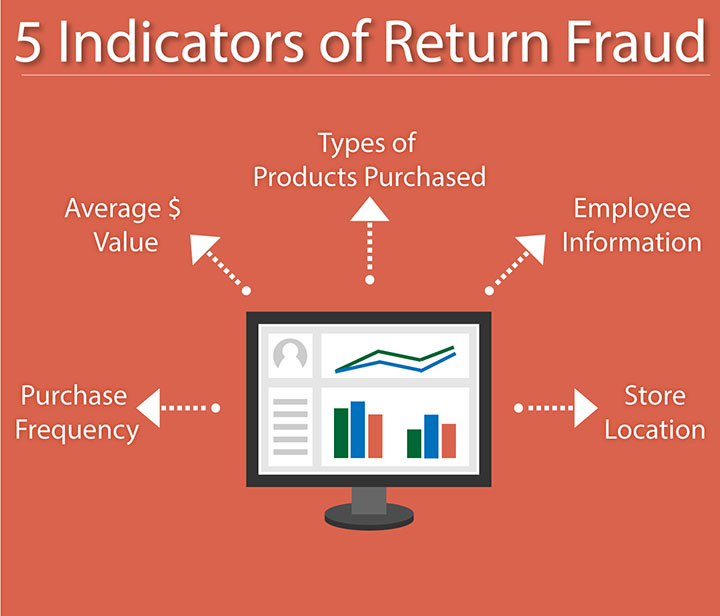How to Identify and Fight Merchandise Return Fraud
Retailers are too familiar with the fact that sales are not final and today some “customers” are engaging in merchandise return fraud to rip off local businesses. You need to understand what return fraud is, and what steps to take to cut those losses.
According to the National Retail Federation, merchandise return fraud is a steadily growing problem for retailers with loss estimates reaching as high as $9.6 billion. The 2017 NRF National Retail Security Survey done in partnership with the University of Florida shows the average loss per return fraud incident ($1,766) is more than double the average shoplifting incident ($800). It is an issue that doesn’t appear to have an easy solution, or is one that will go away soon. The NRF reports that an incredible 95.2% of retailers experienced some form of return fraud in 2016.
Traits and Definition of Merchandise Return Fraud
Signs of merchandise return fraud are not greatly different than any other kind of theft, but includes some variables that typical shoplifting doesn’t. Such as:
An obvious increase in the number of returns may indicate that your store is being targeted because of a friendly return policy.
The lack of enforcement of the company’s return policy could show possible employee involvement.
A store might have to hold more markdown sales due to an increased number of returned items.
Both return fraud and shoplifting show a high shrink rate where retailers notice inventory disappearing between counts. A good way to monitor this and protect against it is to implement a system of cycle counts, periodically counting different sections of your store.
There are many kinds of merchandise return fraud ranging from nearly accidental to the kind perpetrated by organized crime. An article in Loss Prevention Media Insider (LPM) gives definitions to various forms of return fraud. It says, opportunistic return abuse is the most innocent form of fraud and is where a customer is refunded an amount greater than they paid for an item. Blatant return fraud can include return of stolen merchandise, check fraud or price manipulation, where price tags are altered or packaging is switched prior to return.
Intentional return abuse is deliberately taking advantage of a store’s return policy for personal monetary gain. Some people who engage in this often purchase an item with the intent to use it and then return it for a refund. Items “rented” in this fashion range from party dresses to mechanic’s tools and account for approximately 52% of fraudulent returns.
ORC FUELING RETURN FRAUD FLAMES
Organized retail crime (ORC) and computer technology have spurred the increase in return fraud.
Kevin Thomas, former corporate loss prevention investigations manager for Office Depot, told LPM Insider how computer technology is used in many types of return fraud and abuse. He explained that criminals can now place their own computer-generated UPCs (Universal Product Code) on top of the actual UPC to generate more refund dollars or gift card fraud.
The NRF study also shows the variety of payment options today adds to the increase in merchandise return fraud. Online purchases make it difficult for retailers to identify customers, and sometimes there is a lag between when a product is ordered and when the sale is confirmed.
How to Cut Your Losses
What is a retailer to do? You want to encourage customers to shop with you and making returns easier is part of that service. So, often return policies are not exactly rigorous. However, retailers are adjusting to limit the losses. The NRF says nearly 30% of retailers updated their return policies in 2017, an increase over the previous two years.
A CNBC study of big-box retail stores suggests the following return policies.
Stores should require:
A receipt for every return.
Product packaging to be fully intact.
Short time frames for allowing returns.
A form of identification from every customer making a return, so you can watch for repeat offenders.
If a customer doesn’t have a receipt, offer:
Exchanges only.
Store credit, instead of gift cards that can be used online.
The Balance, a financial consulting company, offers these additional suggestions:
Providing gift receipts can protect your business and increase customer satisfaction. Some retailers will not exchange merchandise without a sales or gift receipt.
Determine and indicate to customers what condition merchandise must be in when returned and assess restocking fees for open items.
Place your policy in plain view at the checkout stands.
Print return policies on sales receipts to avoid any confusion.
Using Technology to Fight Fraud
Point of sale systems are essential in controlling inventory, recording sales and making returns easy and accurate with or without the original sales receipts. These systems allow you to connect returns to their original sale price. They also allow you to gain valuable customer information by simply swiping a driver’s license or other applicable identification. POS systems also assist retailers in identifying customers who regularly return merchandise and who may be trying to cheat your store.
LPM Insider says the key to utilizing a POS system is giving a definition to a “fraudulent return.” While that definition can vary by personal preference, it should consistently feature the following criteria:

- The frequency or number of purchases versus returns processed for that customer, whether or not any of these were tagged as fraudulent.
- The type of products the customer purchased.
- The employees involved in the transaction.
- The store locations.
- And the average dollar value of each purchase.
Unfortunately, as retailers improve their inventory control and refund policies, people seeking to circumvent those processes will find new ways to do so. It is impossible to prevent all crime, but you can stay ahead of it by improving your technology and your return policies, and remaining vigilant.
Get the Return Fraud Prevention Checklist
Brian Bullock
Author


